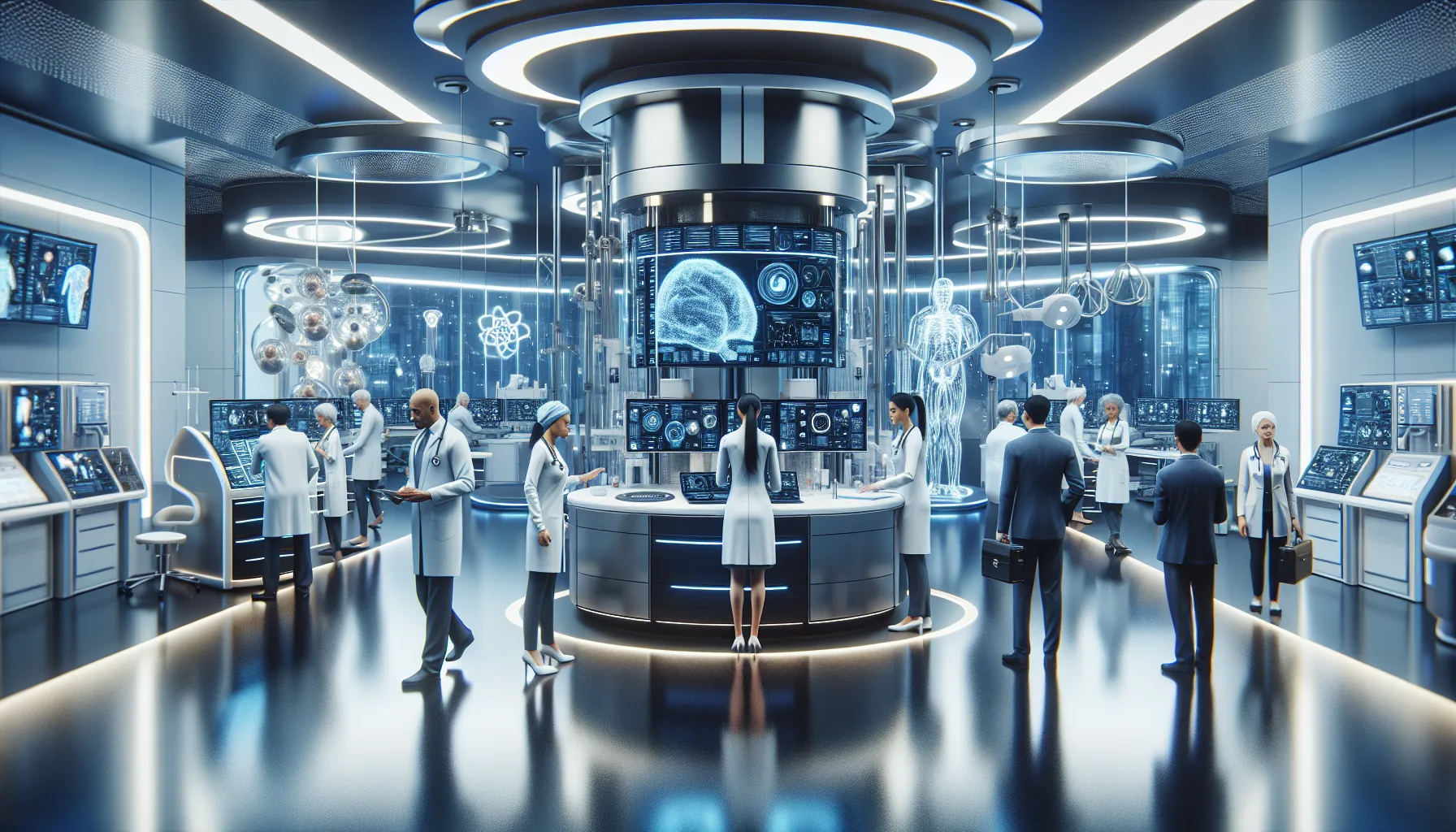In today’s IELTS Reading practice, we’ll explore the fascinating topic of “AI for reducing human error in medical diagnostics”. This subject is not only relevant to current technological advancements but also presents an excellent opportunity to enhance your reading comprehension skills for the IELTS exam. Let’s dive into a full IELTS Reading test, complete with passages, questions, and answers, all centered around this cutting-edge theme.
Nội dung bài viết
 AI in medical diagnostics
AI in medical diagnostics
IELTS Reading Test: AI in Medical Diagnostics
Passage 1 (Easy Text)
The role of Artificial Intelligence (AI) in modern healthcare is becoming increasingly significant, particularly in the realm of medical diagnostics. As healthcare systems worldwide grapple with the challenges of human error, AI offers a promising solution to enhance accuracy and efficiency in diagnosing various medical conditions.
Human error in medical diagnostics is a persistent issue that can lead to misdiagnosis, delayed treatment, and in some cases, life-threatening consequences. Factors contributing to these errors include fatigue, cognitive biases, and information overload. Healthcare professionals, despite their extensive training and expertise, are not immune to these human limitations.
AI systems, on the other hand, can process vast amounts of data quickly and consistently, without succumbing to fatigue or bias. These systems utilize machine learning algorithms to analyze medical images, patient records, and research data, providing support to healthcare professionals in making more accurate diagnoses.
One area where AI has shown particular promise is in radiology. AI-powered image analysis can detect subtle abnormalities in X-rays, MRIs, and CT scans that might be overlooked by human radiologists. This technology doesn’t aim to replace human experts but rather to augment their capabilities, acting as a “second pair of eyes” to catch potential errors or oversights.
Another application of AI in reducing diagnostic errors is through natural language processing (NLP). NLP algorithms can analyze patient records, medical literature, and clinical notes to identify patterns and correlations that might not be immediately apparent to human practitioners. This can help in early detection of diseases and in suggesting potential diagnoses based on a patient’s symptoms and medical history.
While the integration of AI in medical diagnostics offers numerous benefits, it also presents challenges. Ethical considerations, data privacy concerns, and the need for regulatory frameworks are all important factors that need to be addressed as this technology continues to evolve and become more prevalent in healthcare settings.
Questions for Passage 1
1-5. Choose the correct letter, A, B, C, or D.
-
The main focus of the passage is on:
A) The challenges in modern healthcare
B) The role of AI in reducing human error in medical diagnostics
C) The limitations of human doctors
D) The future of radiology -
According to the passage, human error in medical diagnostics can be caused by:
A) Lack of medical knowledge
B) Poor hospital equipment
C) Fatigue and cognitive biases
D) Patient non-compliance -
AI systems in medical diagnostics are described as:
A) A replacement for human doctors
B) Prone to the same errors as humans
C) Capable of processing large amounts of data quickly
D) Limited to analyzing medical images -
The passage suggests that AI in radiology:
A) Is designed to replace human radiologists
B) Can only analyze X-rays
C) Acts as a support tool for human experts
D) Is less accurate than human analysis -
Natural Language Processing in medical AI is used to:
A) Translate medical terms for patients
B) Analyze patient records and medical literature
C) Improve communication between doctors
D) Write medical reports
6-10. Do the following statements agree with the information given in the passage?
Write TRUE if the statement agrees with the information
Write FALSE if the statement contradicts the information
Write NOT GIVEN if there is no information on this
-
Human error in medical diagnostics can sometimes lead to life-threatening consequences.
-
AI systems in medical diagnostics are completely error-free.
-
The integration of AI in healthcare is without any challenges or concerns.
-
AI can help in the early detection of diseases by analyzing patient data.
-
All hospitals worldwide have already fully integrated AI into their diagnostic processes.
Passage 2 (Medium Text)
The integration of Artificial Intelligence (AI) in medical diagnostics represents a paradigm shift in healthcare, offering unprecedented opportunities to mitigate human error and enhance patient outcomes. This technological revolution is not merely about replacing human judgment but rather about creating a symbiotic relationship between AI systems and healthcare professionals.
One of the most promising applications of AI in reducing diagnostic errors lies in its ability to process and analyze complex, multimodal data. Traditional diagnostic methods often rely on a limited set of inputs, such as a patient’s symptoms and basic test results. AI, however, can simultaneously analyze a patient’s genetic information, historical medical records, lifestyle factors, and even environmental data to provide a more comprehensive diagnostic picture. This holistic approach significantly reduces the likelihood of overlooking crucial factors that might contribute to a misdiagnosis.
The predictive capabilities of AI systems are particularly noteworthy in the context of error reduction. By leveraging machine learning algorithms and vast databases of medical information, AI can identify subtle patterns and correlations that might escape even the most experienced clinicians. For instance, an AI system might detect early warning signs of a rare disease based on a combination of seemingly unrelated symptoms, prompting further investigation and potentially leading to earlier, more accurate diagnoses.
In the realm of medical imaging, AI’s contribution to error reduction is particularly significant. Computer vision algorithms can analyze medical images with a level of detail and consistency that surpasses human capabilities. These systems can detect minute anomalies in X-rays, MRIs, and CT scans, flagging potential issues for human review. Moreover, AI can compare a patient’s images against vast databases of similar cases, providing valuable context and supporting more informed decision-making.
The implementation of AI in clinical decision support systems (CDSS) is another crucial aspect of error reduction in medical diagnostics. These systems can provide real-time recommendations to healthcare providers, offering evidence-based suggestions for diagnosis and treatment. By integrating the latest medical research and guidelines, CDSS can help ensure that diagnoses are made based on the most current and comprehensive information available, reducing the risk of errors due to outdated knowledge or overlooked recent developments in medical science.
However, it’s important to note that the integration of AI in medical diagnostics is not without challenges. Issues of data privacy, algorithmic bias, and the need for robust validation of AI systems in clinical settings are significant concerns that need to be addressed. Furthermore, there’s a need for healthcare professionals to develop new skills to effectively interact with and interpret the outputs of AI systems, ensuring that this technology enhances rather than complicates the diagnostic process.
Despite these challenges, the potential of AI to reduce human error in medical diagnostics is immense. As the technology continues to evolve and become more sophisticated, it promises to play an increasingly vital role in improving diagnostic accuracy, enhancing patient safety, and ultimately saving lives. The future of healthcare lies in the judicious integration of AI technologies, creating a more accurate, efficient, and patient-centric diagnostic process.
Questions for Passage 2
11-14. Complete the sentences below.
Choose NO MORE THAN TWO WORDS from the passage for each answer.
-
AI can analyze __ __ data to provide a more comprehensive diagnostic picture.
-
The __ __ of AI systems allow them to identify subtle patterns that human clinicians might miss.
-
In medical imaging, __ __ algorithms can analyze images with great detail and consistency.
-
Clinical decision support systems can provide __ __ recommendations to healthcare providers.
15-20. Complete the summary below.
Choose NO MORE THAN TWO WORDS from the passage for each answer.
AI in medical diagnostics offers significant potential for reducing human error. It can process (15) __ data, including genetic information and lifestyle factors, to provide a comprehensive diagnostic picture. AI’s (16) __ capabilities allow it to detect early warning signs of diseases. In medical imaging, AI can identify (17) __ that humans might miss. Clinical decision support systems powered by AI offer (18) __ suggestions for diagnosis and treatment. However, the integration of AI in healthcare faces challenges, including concerns about (19) __ and the need for (20) __ of AI systems in clinical settings.
Passage 3 (Hard Text)
The integration of Artificial Intelligence (AI) in medical diagnostics represents a watershed moment in healthcare, heralding a new era of precision and reliability in disease detection and patient care. While the potential of AI to mitigate human error is vast, it is crucial to examine this technological revolution through a multifaceted lens, considering its implications for clinical practice, patient outcomes, and the broader healthcare ecosystem.
At the core of AI’s capability to reduce diagnostic errors lies its unparalleled capacity for data processing and pattern recognition. Machine learning algorithms, particularly deep learning neural networks, can assimilate and analyze vast troves of medical data with a speed and accuracy that far surpasses human cognitive abilities. These systems can identify subtle correlations and anomalies in patient data, ranging from genetic markers to lifestyle factors, that might elude even the most astute clinicians. This comprehensive analysis not only enhances diagnostic accuracy but also facilitates a more holistic approach to patient care, considering a broader spectrum of factors that may influence health outcomes.
The application of AI in medical imaging has been particularly transformative. Convolutional neural networks (CNNs) have demonstrated remarkable prowess in analyzing radiological images, often outperforming human experts in detecting subtle abnormalities. For instance, AI systems have shown superior accuracy in identifying early-stage lung nodules in chest X-rays and detecting precancerous lesions in mammograms. This capability not only reduces the likelihood of missed diagnoses but also has the potential to expedite the diagnostic process, enabling earlier interventions and improved patient prognosis.
Moreover, AI’s role in reducing diagnostic errors extends beyond image analysis. Natural Language Processing (NLP) algorithms can sift through vast amounts of unstructured medical data, including clinical notes, research papers, and patient records, to extract relevant information and identify potential diagnostic clues. This ability to synthesize information from diverse sources can help clinicians make more informed decisions, reducing the risk of errors stemming from information overload or overlooked relevant data.
The integration of AI into Clinical Decision Support Systems (CDSS) represents another frontier in error reduction. These systems can provide real-time, evidence-based recommendations to healthcare providers, taking into account the latest medical research, treatment guidelines, and patient-specific factors. By offering a “second opinion” based on comprehensive data analysis, CDSS can help mitigate cognitive biases and knowledge gaps that may lead to diagnostic errors.
However, the implementation of AI in medical diagnostics is not without challenges and potential pitfalls. One significant concern is the issue of algorithmic bias. AI systems are only as unbiased as the data they are trained on, and if this data reflects existing disparities in healthcare access or outcomes, these biases may be perpetuated or even amplified. Ensuring the diversity and representativeness of training datasets is crucial to developing AI systems that are equitable and effective across diverse patient populations.
Another critical consideration is the need for explainable AI in medical diagnostics. While some AI models, particularly deep learning networks, can achieve high accuracy, their decision-making processes often lack transparency. This “black box” nature can be problematic in a clinical setting, where understanding the rationale behind a diagnosis is crucial for both healthcare providers and patients. Developing AI systems that can provide clear explanations for their outputs is essential for building trust and facilitating meaningful human-AI collaboration in healthcare.
The integration of AI in medical diagnostics also raises important ethical and legal questions. Issues of data privacy, informed consent, and liability in cases of AI-assisted misdiagnosis need to be carefully addressed. Regulatory frameworks must evolve to keep pace with technological advancements, ensuring that AI systems are rigorously validated for safety and efficacy before clinical deployment.
Furthermore, the successful integration of AI in medical diagnostics necessitates a shift in medical education and training. Healthcare professionals must develop new competencies to effectively interact with AI systems, interpret their outputs, and understand their limitations. This requires not only technical knowledge but also critical thinking skills to judiciously apply AI-generated insights in the context of individual patient care.
In conclusion, while AI holds immense promise for reducing human error in medical diagnostics, its integration into clinical practice must be approached with both enthusiasm and caution. The potential benefits in terms of improved diagnostic accuracy, earlier disease detection, and more personalized patient care are significant. However, realizing these benefits requires addressing challenges related to bias, explainability, ethics, and education. As we navigate this technological frontier, the goal should be to create a synergistic relationship between human expertise and artificial intelligence, leveraging the strengths of both to enhance the quality and safety of healthcare delivery.
Questions for Passage 3
21-26. Complete the summary using the list of words, A-L, below.
AI in medical diagnostics offers significant potential for reducing human error through its (21) __ data processing and pattern recognition capabilities. In medical imaging, (22) __ have shown remarkable accuracy in detecting abnormalities. (23) __ algorithms can analyze unstructured medical data to extract relevant information. The integration of AI into (24) __ provides real-time, evidence-based recommendations to healthcare providers. However, challenges such as (25) __ and the need for (26) __ in AI systems need to be addressed for successful implementation.
A. Natural Language Processing
B. algorithmic bias
C. unparalleled
D. Convolutional neural networks
E. explainable AI
F. Clinical Decision Support Systems
G. limited
H. machine learning
I. data privacy
J. artificial neural networks
K. predictive analytics
L. Deep Learning
27-30. Do the following statements agree with the claims of the writer in the passage?
Write YES if the statement agrees with the claims of the writer
Write NO if the statement contradicts the claims of the writer
Write NOT GIVEN if it is impossible to say what the writer thinks about this
-
AI systems in medical diagnostics are completely free from biases and errors.
-
The development of explainable AI is crucial for building trust in AI-assisted medical diagnostics.
-
Current regulatory frameworks are sufficient to address the challenges posed by AI in healthcare.
-
The integration of AI in medical diagnostics will eventually eliminate the need for human healthcare professionals.
31-35. Choose the correct letter, A, B, C or D.
-
According to the passage, machine learning algorithms in medical diagnostics:
A) Can only process genetic data
B) Are limited to analyzing medical images
C) Can identify subtle correlations in various types of patient data
D) Are designed to replace human clinicians entirely -
The passage suggests that AI in medical imaging:
A) Is only effective for chest X-rays
B) Has shown superior accuracy in detecting certain abnormalities compared to human experts
C) Can only be used as a secondary diagnostic tool
D) Is not yet reliable enough for clinical use -
The author’s stance on the integration of AI in medical diagnostics can best be described as:
A) Overwhelmingly enthusiastic
B) Deeply skeptical
C) Cautiously optimistic
D) Entirely neutral -
The passage indicates that the successful integration of AI in medical diagnostics requires:
A) Complete replacement of human healthcare providers
B) Focusing solely on technological advancements
C) Ignoring ethical considerations
D) Changes in medical education and training -
The main purpose of the passage is to:
A) Argue against the use of AI in medical diagnostics
B) Provide a balanced view of the potential and challenges of AI in reducing diagnostic errors
C) Promote specific AI technologies for medical use
D) Criticize current medical diagnostic practices
Answer Key
Passage 1
- B
- C
- C
- C
- B
- TRUE
- FALSE
- FALSE
- TRUE
- NOT GIVEN
Passage 2
- complex multimodal
- predictive capabilities
- computer vision
- real-time
- multimodal
- predictive
- anomalies
- evidence-based
- data privacy
- robust validation
Passage 3
- C
- D
- A
- F
- B
- E
- NO
- YES
- NOT GIVEN
- NO
- C
- B
- C
- D
- B
Conclusion
This IELTS Reading practice test on “AI for reducing human error in medical diagnostics” offers a comprehensive exploration of this cutting-edge topic while honing your reading comprehension skills. Remember to practice regularly with various IELTS reading strategies to improve your performance. For more insights on AI in healthcare, you might find our article on AI-driven healthcare solutions helpful. Keep refining your skills and stay updated with the latest developments in AI and healthcare to excel in your IELTS Reading test!


